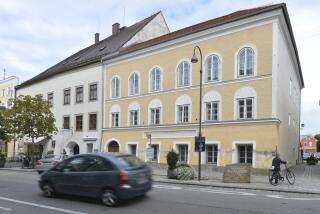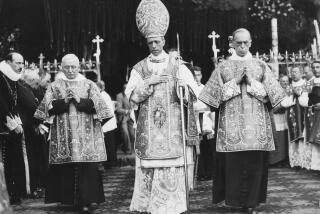Austrian Clergy’s Support for Hitler Detailed
VIENNA — Some Austrians were clearly not ready for Stefan Moritz’s book about their country’s pro-Nazi priests -- bishops who hushed up the Holocaust and a prelate who helped thousands of Hitler’s henchmen escape justice.
“A woman just screamed, ‘Heil Hitler,’ and hung up,” Moritz said. “Another caller asked me if I were a Jew because only a Jew could write garbage like this.”
Moritz, who isn’t Jewish, has shaken up his country with a book asserting that Austria’s Roman Catholic Church ignored and even abetted Nazi horrors.
By publishing “Gruess Gott und Heil Hitler” (“Hail God and Heil Hitler”), Moritz, 36, is treading on sensitive ground. After all, nearly 80% of Austrians are Roman Catholics.
Not all Austrian clergy were cowards or collaborators. Moritz cites the case of Franz Reinisch, banned from preaching because of his critical stance toward the Nazis. The church, instead of backing Reinisch, expelled him from his Pallottine order. He was executed in 1942 after refusing to swear loyalty to Hitler and join his army, Moritz writes.
That’s only one example in his argument that the Austrian church struck a bargain with the devil to survive, and that many priests and bishops went beyond silence to actively support the Nazis.
Dozens of documents -- many from parish archives -- include:
* A chillingly dispassionate entry dated Nov. 26, 1942, from the Austrian Bishops’ Conference, which skims over the mass deportation of Jews to Nazi death camps by noting that over one year, “33 transports of 1,000 each have gone to Poland.” By that time, some bishops were signing off with “Heil Hitler” on official letters and priests were authorized to display the swastika.
* Influential Jesuit Mario von Galli described Jews as “God’s murderers” who deserve persecution. In 1940, as Gypsies started joining the Jews on death trains packed to the suffocation point, the Vienna archdiocese urged all parishes to do their utmost to “combat the Gypsy chaos” in the Austrian capital by reporting Gypsies to police.
* The parish newspaper “Erdberger Pfarrblatt” urged Catholics to support Hitler by declaring: “One people -- one Reich -- one Fuehrer -- one God!”
* Rural priest Franz Mandl, in a lectern-thumping speech, called Hitler “the greatest human being” -- one of dozens of priests who were documented praising the Nazi dictator.
* An internal church document blamed Jewish politicians and writers for the decline in pure-race Germanic births.
* A listing of pro-Hitler Austrian clergy staying in or promoted to leading positions after the war. It included Bishop Alois Hudal, who boasted of helping about 50,000 war crimes suspects hide or escape. Among them was Franz Stangl, commander of the Treblinka death camp in Poland, where 800,000 Jews were killed. He was arrested in Brazil after two decades on the run, using a false passport procured through Hudal.
After decades of denial, Austria has come a long way in acknowledging that Hitler, its native son, counted Austrians like Stangl among his most ruthless henchmen and that he had more rabid supporters here than in Germany.
While latent anti-Semitism still is exploited by a few far-right politicians, government leaders now publicly condemn the country’s Nazi past, and laws regulating restitution have paid out millions of dollars.
Austria’s Gothic cathedrals and onion-domed village churches have resisted scrutiny, however.
Few cardinals and bishops have spoken forthrightly about the links of some of their predecessors to the Nazi regime. Revelations two years ago that slave laborers tilled church fields in Austria were only acknowledged after media reports could no longer be ignored.
In neighboring Germany, too, allegations persist that the Roman Catholic Church failed to speak out against the Nazi Holocaust and to properly acknowledge its silent complicity.
“A Moral Reckoning: The Role of the Catholic Church in the Holocaust and Its Unfulfilled Duty of Repair,” a new book by American historian Daniel Goldhagen, reexamines the case against the church, and has been attacked by critics and church officials as lacking historical foundation.
It ran into more controversy a few weeks ago when a German court ordered a picture caption blacked out in the German translation. The court was acting on a complaint by the Munich diocese that the caption misidentified a church official at a Nazi event as Michael Faulhaber, then the cardinal of Munich.
Goldhagen claimed that it was “a desperate attempt on the part of the church to try and torpedo this book and avoid a real discussion.”
In fact, influential prelates in Germany now appear ready to deal with the past; Cardinal Karl Lehmann of Mainz urged the Vatican earlier this year to open its Nazi-era archives for the first time.
No such calls have come from Austria’s clergy, and those still alive with personal memories of the church’s role more than half a century ago are either reluctant to talk or plead fading memory.
“Mayer, the principal of our school, he was an ‘illegal one,’ ” said Hermine Reiterer, 83, using the term for the keenest Nazis, who joined Hitler’s party in the early 1930s while it was still banned in Austria. “He was extremely active in our church.”
Maria, 85, who refuses to give her full name, recalls that her parish priest in Hitler’s boyhood city of Linz rang the bells to celebrate Nazi Germany’s annexation of Austria in 1938. Three years later, she says, he exhorted parishioners from the pulpit against “the godless Bolsheviks” as Hitler invaded the Soviet Union.
Moritz, however, gives names, dates and concrete examples.
Historian Erika Weinzierl, a Roman Catholic and Austria’s lay authority on her church, calls his book “accurate and solidly crafted.”
Like the Vatican, Austria’s Roman Catholic Church spokesman, Erich Leitenberger, describes the clergy as a victim of the Nazis. But even he acknowledges the existence of “misguided Catholics” in the church hierarchy, “who thought their prejudices were confirmed by National Socialism” -- the Nazi ideology.
Weinzierl, however, suggests such statements fall short at a time when the Vatican is under pressure to open its archives.
“There has never been a broad acknowledgment of guilt on the part of the church, either here or for the whole church in general,” she said. “It’s time for a sign that this chapter, too, is thrown open.”
More to Read
Sign up for Essential California
The most important California stories and recommendations in your inbox every morning.
You may occasionally receive promotional content from the Los Angeles Times.










